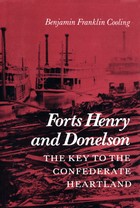2 books about Donelson

Decisions at Forts Henry and Donelson
The Twenty One Critical Decisions that Defined the Battles
Hank Koopman
University of Tennessee Press, 2024
The Battles of Forts Henry and Donelson took place in February of 1862 and were early indicators of the success the US would have in the Civil War’s Western Theater. Due to Kentucky’s neutrality at the time, Brig. Gen. Daniel S. Donelson was instructed to find suitable sites for fortification along the Tennessee River but just inside the state boundaries of Tennessee. Forts Henry and Donelson were constructed in the summer of 1861 and were quickly identified by Gen. Ulysses S. Grant as strategic fortifications that, if conquered, would open the Federal Army’s path to Alabama and Mississippi. Fort Henry fell to Federal control on February 6, 1862, and Fort Donelson fell six days later. With the Tennessee and Mississippi Rivers now open to Federal gunboats, Grant and his army would head southwest to Memphis and on to Vicksburg.
Decisions at Forts Henry and Donelson explores the critical decisions made by Confederate and Federal commanders during the battle and how these decisions shaped its outcome. Rather than offering a history of the battle, Hank Koopman hones in on a sequence of critical decisions made by commanders on both sides of the conflict to provide a blueprint of the Battles of Forts Henry and Donelson at their tactical core. Identifying and exploring the critical decisions in this way allows students of the battles to progress from a knowledge of what happened to a mature grasp of why events happened.
Complete with maps and a driving tour, Decisions at Forts Henry and Donelson is an indispensable primer, and readers looking for a concise introduction to these battles can tour this sacred ground—or read about it at their leisure—with key insights into the campaigns and a deeper understanding of the Civil War itself.
Decisions at Forts Henry and Donelson is the eighteenth in a series of books that will explore the critical decisions of major campaigns and battles of the Civil War.
Decisions at Forts Henry and Donelson explores the critical decisions made by Confederate and Federal commanders during the battle and how these decisions shaped its outcome. Rather than offering a history of the battle, Hank Koopman hones in on a sequence of critical decisions made by commanders on both sides of the conflict to provide a blueprint of the Battles of Forts Henry and Donelson at their tactical core. Identifying and exploring the critical decisions in this way allows students of the battles to progress from a knowledge of what happened to a mature grasp of why events happened.
Complete with maps and a driving tour, Decisions at Forts Henry and Donelson is an indispensable primer, and readers looking for a concise introduction to these battles can tour this sacred ground—or read about it at their leisure—with key insights into the campaigns and a deeper understanding of the Civil War itself.
Decisions at Forts Henry and Donelson is the eighteenth in a series of books that will explore the critical decisions of major campaigns and battles of the Civil War.
[more]

Forts Henry And Donelson
The Key to the Confederate Heartland
Benjamin Franklin Cooling
University of Tennessee Press, 1987
Forts Henry and Donelson portray the tapestry of war and society in the upper southern heartland of Tennessee and Kentucky after key Union victories in February 1862. Those victories, notes Benjamin Franklin Cooling, could have delivered the decisive blow to the Confederacy in the West and ended the war in that theater. Instead, what followed was terrible devastation and bloodshed that embroiled soldier and civilian alike. Cooling compellingly describes a struggle that was marked not only by the movement of armies and the strategies of generals but also by the rise of guerrilla bands and civil resistance. It was, in part, a war fought for geography—for rivers and railroads and for strategic cities such as Nashville, Louisville, and Chattanooga. But it was also a war for the hearts and minds of the populace. “Stubborn civilian opposition to Union invaders,” Cooling writes, “prompted oppressive military occupation, subversion of civil liberties, and confiscation of personal property in the name of allegiance to the United States—or to the Confederacy, for that matter, since some Unionist southerners resented Confederate intrusion fully as much as their secessionist neighbors opposed Yankee government.” In exploring the complex terrain of “total war” that steadily engulfed Tennessee and Kentucky, Cooling draws on a huge array of sources, including official military records and countless diaries and memoirs. He makes considerable use of the words of participants to capture the attitudes and concerns of those on both sides. The result is a masterful addition to Civil War literature that integrates the military, social, political, and economic aspects of the conflict into a large and endlessly fascinating picture
[more]
READERS
Browse our collection.
PUBLISHERS
See BiblioVault's publisher services.
STUDENT SERVICES
Files for college accessibility offices.
UChicago Accessibility Resources
home | accessibility | search | about | contact us
BiblioVault ® 2001 - 2024
The University of Chicago Press









